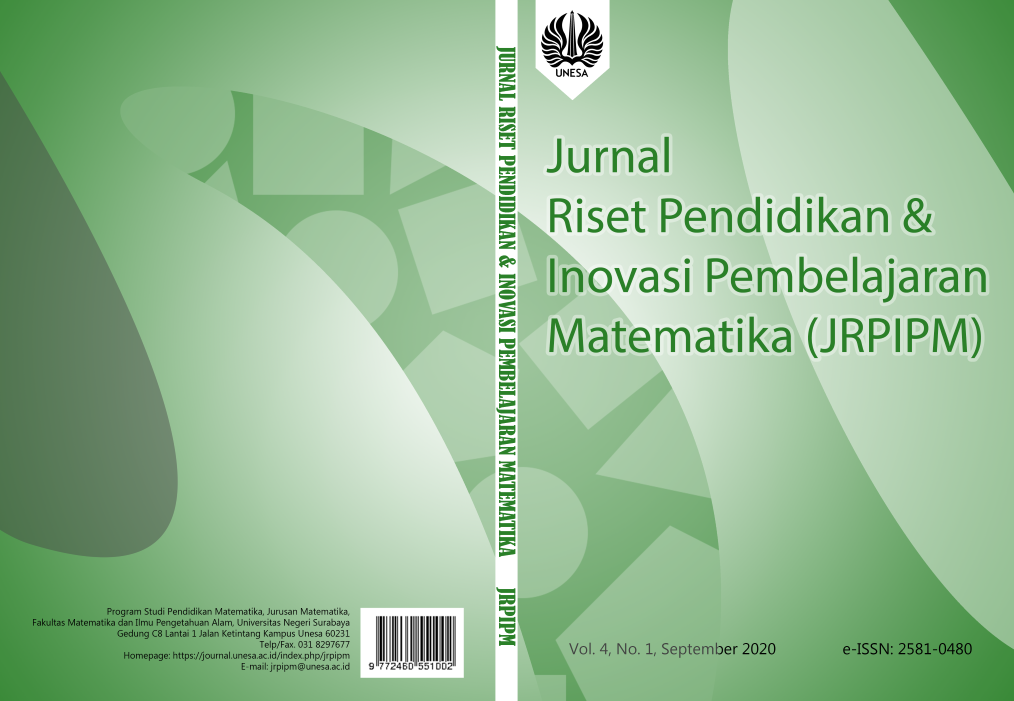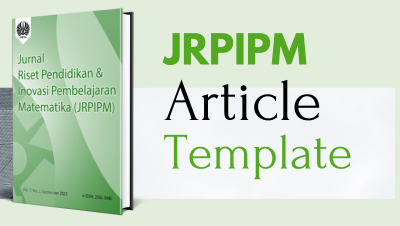How is the Statistical Literacy of Upper Secondary Students Based on Gender Differences?
DOI:
https://doi.org/10.26740/jrpipm.v4n1.p53-67Keywords:
Statistical Literacy, Upper Secondary Students, GenderAbstract
The study aimed to describe the statistical literacy of upper secondary student based on gender differences. There are a gap between female sex is not necessarily feminine and conversely male students are not necessarily masculine, there is a possibility that the person is of type androgyny or indistinguishable. The study was conducted in four students with different gender type that is masculine type, feminine type, androgynous type, and indistinguished type. Data was collected using the Statistical Literacy Test, developed based on the statistical framework about statistical literacy ability with indicator of understanding data, interpreting data, and communicating data. The result with quantitave and qualitative research revealed significant differences statistical literacy based on gender differences. In this study shows that the feminine type has the highest statistical literacy skill between other gender types in understanding data, interpreting data, and communicating data. In understanding data, the feminine type can read data and supported with arguments that are easily understood. In interpreting data, feminine type are able to make predictions of future possibilities, can determine the value of increase and decrease in data, able to think critically about the data presented and able to make conclusions based on the data. But, in communicating data feminine type make mistakes in changing the shape of data from graphs to table forms. Then, statistical literacy ability followed by androgynous type. Then, the lowest statistical ability in the masculine type and the cannot be distinguished type.References
<p>[1] J. M. Watson, œStatistical Literacy at School: Growth and Goals. Lawrence Erlbaum, NJ Mahwah, 2006.</p><p>[2] I. Gal, œAdults Statistical Literacy: Meanings, Components, Responsibilities, <em>Int. Stat. Rev.</em>, vol. 70, no. 1, pp. 125, 2002, doi: 10.1111/j.1751-5823.2002.tb00336.x.</p><p>[3] D. J. Rumsey, œStatistical literacy as a goal for introductory statistics courses, <em>J. Stat. Educ.</em>, vol. 10, no. 3, 2002, doi: 10.1080/10691898.2002.11910678.</p><p>[4] M. Hafiyusholeh, K. Budayasa, and T. Y. E. Siswono, œLiterasi Statistik: Siswa SMA dalam Membaca, Menafsirkan, dan Menyimpulkan Data, <em>Pros. SI MaNIs (Seminar Nas. Integr. Mat. dan Nilai Islam.</em>, vol. 1, no. 1, pp. 7985, 2017.</p><p>[5] J. M. Watson, œStatistical Literacy in the Elementary School: Opportunities for Problem Posing, <em>Math. Probl. posing From Res. to Eff. Pract.</em>, pp. 241256, 2015.</p><p>[6] G. . C Franklin, œGuidelines forassessment and instruction in statistics education (GAISE) report: A pre-K12 curriculum framework., VA Alexandria, 2005.</p><p>[7] NCTM, <em>Curriculum and evaluation standard for school mathematics.</em> Virgina: the national Council of teachers of mathematics ,inc, 1989.</p><p>[8] Best & Khan, <em>Research in Education</em>. United States of Amerika: A Viacom Company, 1998.</p><p>[9] Permendikbud, <em>Permendikbud Nomor 24 Tentang Kompetensi Inti dan Kompetensi Dasar Tahun 2016</em>. Jakarta: Kemendikbud, 2016.</p><p>[10] C. S. Carmichael, M. Phil, M. Ed, and B. Sc, œThe development of middle school children s interest in statistical literacy, no. November, 2010.</p><p>[11] J. Watson, œAssessing Statistical Thinking Using the Media, 2016.</p><p>[12] I. Gal, œUnderstanding statistical literacy: About knowledge of contexts and models, <em>Actas del Terc. Congr. Int. Virtual Educ. EstadÃstica</em>, 2019, [Online]. Available: http://digibug.ugr.es/bitstream/handle/10481/55029/gal.pdf?sequence=1&isAllowed=y.</p><p>[13] OECD, <em>A 2018 Assessment and Analytical Framework</em>. Paris: OECD Publishing, 2019.</p><p>[14] I. Maryati and N. Priatna, œAnalisis Kemampuan Literasi Statistis Siswa Madrasah Tsanawiyah dalam Materi Statistika, <em>J. Medives J. Math. Educ. IKIP Veteran Semarang</em>, vol. 2, no. 2, p. 205, 2018, doi: 10.31331/medives.v2i2.640.</p><p>[15] M. A. Pratama, Supahar, D. P. Lestari, W. K. Sari, T. S. Y. Putri, and V. A. K. Adiatmah, œData literacy assessment instrument for preparing 21 Cs literacy: Preliminary study, <em>J. Phys. Conf. Ser.</em>, vol. 1440, no. 1, 2020, doi: 10.1088/1742-6596/1440/1/012085.</p><p>[16] G. Thirafi, œAnalisis Tingkat iterasi Statistik pada Siswa Kelas IX MTS. AL-AZIZIYAH PUTRA GUNUNG SARI TAHUN PELAJARAN 2016/2017, vol. 6, pp. 59, 2017.</p><p>[17] M. Fakih, <em>Analisis Gender dan Transformasi sosial</em>. Yogyakarta: INSISTPress, 2008.</p><p>[18] I. Risywandha and S. Khabibah, œLiterasi Matematika Siswa Sma Kelas X Dalam Menyelesaikan Soal Model Pisa Ditinjau Dari Perbedaan Gender, <em>MATHEdunesa</em>, vol. 7, no. 2, pp. 248255, 2018.</p><p>[19] A. M. Hyde, J.S. and Durik, œGender, competence, and motivation., <em>Handb. competence Motiv.</em>, p. pp.375-391, 2005.</p><p>[20] M. L. Kristyasari, S. Yamtinah, S. B. Utomo, Ashadi, and N. Y. Indriyanti, œGender Differences in Students Science Literacy towards Learning on Integrated Science Subject, <em>J. Phys. Conf. Ser.</em>, vol. 1097, no. 1, 2018, doi: 10.1088/1742-6596/1097/1/012002.</p><p>[21] F. F. W. Putri and M. P. Dr. Masiyah, œProfil Kemampuan Penalaran Siswa Smp Dalam Menyelesaikan Masalah Matematika Ditinjau Dari Tipe Kepribadian Dan Jenis Kelamin, <em>J. Ilm. Pendidik. Mat. mathedunesa</em>, vol. 8, no. 58, pp. 3845, 2019.</p><p>[22] A. Yolcu, œMiddle school students statistical literacy: Role of grade level and gender, <em>Stat. Educ. Res. J.</em>, vol. 13, no. 2, pp. 118131, 2014.</p><p>[23] Bem, <em>Pengantar Psikologi Edisi 1 dan 2</em>, Edisi 1 da. Jakarta: Penerbit Airlangga, 1997.</p><p>[24] Miles & Hubberman, <em>Qualitative data analysis: an expanded sourcebook (2nd. Ed)</em>. London: Sage.</p><p>[25] C. Carmichael, R. Callingham, I. Hay, and J. Watson, œStatistical literacy in the middle school: The relationship between interest, self-efficacy and prior mathematics achievement, <em>Aust. J. Educ. Dev. Psychol.</em>, vol. 10, pp. 8393, 2010.</p><p>[26] J. Watson, J., & Moritz, œDevelopment of understanding of sampling for statistical literacy., <em>J. Math. Behav.</em>, vol. 19(1), pp. 109136, 2000.</p>
Downloads
Additional Files
Published
2020-09-30
How to Cite
Risqi, E. N., & Ekawati, R. (2020). How is the Statistical Literacy of Upper Secondary Students Based on Gender Differences?. Jurnal Riset Pendidikan Dan Inovasi Pembelajaran Matematika, 4(1), 53–67. https://doi.org/10.26740/jrpipm.v4n1.p53-67
Issue
Section
Articles
 Abstract views: 486
,
Abstract views: 486
, PDF Downloads: 421
,
PDF Downloads: 421
, PDF Downloads: 0
PDF Downloads: 0






